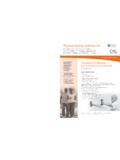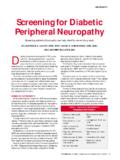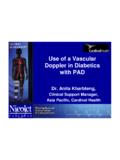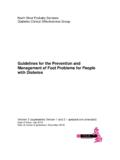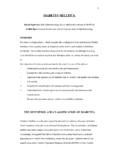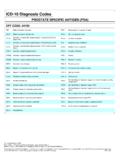Transcription of Screening Tool www.cawc
1 60-second diabetic Foot ScreenScreening Toolinlow Name: Clinician Signature:ID number: Date:Look 20 secondsScoreCare RecommendationsLeft FootRight Foot1. Skin0 = intact and healthy1 = dry with fungus or light callus2 = heavy callus build up3 = open ulceration or history of previous ulcer2. Nails0 = well-kept1 = unkempt and ragged2 = thick, damaged, or infected3. Deformity0 = no deformity2 = mild deformity4 = major deformity4. Footwear0 = appropriate1 = inappropriate2 = causing traumaTouch 10 secondsLeft FootRight FootCare Recommendations5. Temperature Cold0 = foot warm 1 = foot is cold6. Temperature Hot0 = foot is warm1 = foot is hot7. Range of Motion0 = full range to hallux1 = hallux limitus2 = hallux rigidus 3 = hallux amputationAssess 30 secondsLeft FootRight FootCare Recommendations8.
2 Sensation Monofilament Testing0 = 10 sites detected2 = 7 to 9 sites detected4 = 0 to 6 sites detected9. Sensation Ask 4 Questions:i. Are your feet ever numb?ii. Do they ever tingle?iii. Do they ever burn?iv. Do they ever feel like insects are crawling on them?0 = no to all questions2 = yes to any of the questions10. Pedal Pulses0 = present1 = absent11. Dependent Rubor0 = no1 = yes12. Erythema0 = no1 = yes Score Totals = Screening for foot ulcers and/or limb-threatening complications. Use the highest score from left or right = 0 to 6 recommend Screening yearly Score = 7 to 12 recommend Screening every 6 months Score = 13 to 19 recommend Screening every 3 months Score = 20 to 25 recommend Screening every 1 to 3 months Comments:1 Adapted from Inlow S.
3 A 60 second foot exam for people with diabetes. Wound Care Canada. 2004;2(2):10-11. CAWC 2011 101 EInstructions for UseGeneral Guidelines: This tool is designed to assist in Screening persons with diabetes to prevent or treat diabetes-related foot ulcers and/or limb-threatening complications. The screen should be completed on admission of any person with diabetes and then repeated as directed by risk and clinical judgment. Do not confuse patient visits with patient Screening . Your patient may require frequent and regular visits for routine care but complete the Screening as indicated or as relevant based on clinical judgment. Specific Instructions: Step 1: Explain Screening to the patient and have them remove their shoes, socks from both feet.
4 Step 2: Remove any dressings or devices that impair the Screening . Step 3: Review each of the parameters for each foot as listed in the Inlow s 60-second diabetic Foot Screen and select the appropriate score based on patient s status. (An amputation may affect the score on the affected limb.) Step 4: Once the screen is completed determine care recommendations based on patient need, available resources and clinical judgement. Step 5: Use the highest score from either the left or right foot to determine recommended Screening 6: Set up an appointment for the next Screening based on Screening score and clinical ReviewReminder: Strategies for the prevention and management of diabetic foot ulcers need to consider more than just the results from a foot screen.
5 It is important that the health-care professional completes a holistic assessment that also monitors lipids, hypertension, glucose and patient activity and exercise. Persons with diabetes who are cognitively impaired or have diseases such as end-stage renal disease are at higher risk and may need more frequent Screening than Adapted from Inlow S. A 60 second foot exam for people with diabetes. Wound Care Canada. 2004;2(2):10-11. CAWC 2011 101E1. SkinAssess the skin on the foot: top, bottom and sides including between the = skin is intact and has no signs of trauma. No signs of fungus or callus formation1 = skin is dry, fungus such as a moccasin foot or interdigital yeast may be present.
6 Some callus build-up may be noted2 = heavy callus build-up 3 = open skin ulceration present2. NailsAssess toenails to determine how well they are being managed either by the patient or = nails well-kept1 = nails unkempt and ragged2 = nails thick, damaged or infected3. DeformityLook for any bony changes that can put the patient at significant risk and prevent the wearing of off-the-shelf footwear0 = no deformity detected2 = may have some mild deformities such as dropped metatarsal heads (MTHs) (the bones under the fat pads on the ball of the foot). Each MTH corresponds to the toe distal to it, so there is a 1st MTH at the base of the first toe etc.
7 Bunions/Charcot may also be considered a deformity as well as deformities related to = Amputation4. FootwearLook at the shoes that the patient is wearing and discuss what he or she normally wears. 0 = shoes provide protection, support and fit the foot. On removal of the footwear there are no reddened areas on the foot1 = shoes are inappropriate do not provide protection or support for the foot. 2 = shoes are causing trauma (redness or ulceration) to the foot either through a poor fit or a poor style (eg., cowboy boots). 5. Temperature coldDoes the foot feel colder than the other foot or is it colder than it should be considering the environment?
8 This can be indicative or arterial = foot is of normal temperature for environment. 1 = foot is cold compared to other foot or compared to the environment6. Temperature hotDoes the foot feel hotter than the other foot or is it hotter than it should be considering the environment? This can be indicative of an infection or Charcot = foot is of normal temperature for environment1 = foot is hot compared to other foot or compared to the environment7. Range of MotionMove the first toe back and forth plantar flex and = first toe (hallux) is easily moved1 = hallux has some restricted movement2 = hallux is rigid and cannot be moved3 = hallux amputated 8.
9 Sensation Monofilament testingUsing the monofilament, test the sites listed. Do not test over heavy : 1 st, 3rd, 5thMTH: 1 st, 3rd, 5thmidfoot: Medial, Lateral heel top (dorsum) of foot And then score out of 10:0 = 10 out of 10 sites detected2 = 7 to 9 out of 10 sites detected4 = 0 to 6 out of 10 sites detected9. Sensation QuestionsAsk the following four questions:i. Are your feet ever numb?ii. Do they ever tingle?iii. Do they ever burn?iv. Do they ever feel like insects are crawling on them?0 = answered No to all four questions2 = answered Yes to one or more of the four questions10. Pedal pulsesPalpate (feel) the dorsalis pedis pulse located on the top of the foot.
10 If unable to feel the pedal pulse feel for the posterior tibial pulse beneath the medial = pulse present1 = pulse absent11. Dependent ruborPronounced redness of the feet when the feet are down and pallor when the feet are elevated. This can be indicative of arterial = no dependent rubor1 = dependent rubor present12. ErythemaLook for redness of the skin that does not change when the foot is elevated. This can be indicative of infection or Charcot = no redness of the skin1 = redness notedInterpreting ResultsInlow s 60-second diabetic Foot Screen has been designed to allow the clinician to screen persons with diabetes to prevent or treat diabetes-related foot ulcers and/or limb-threatening complications.




